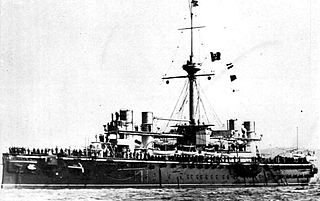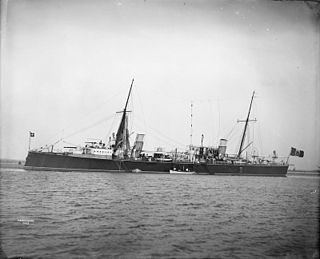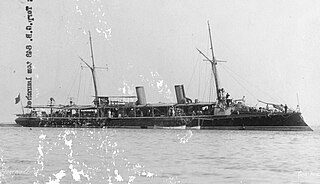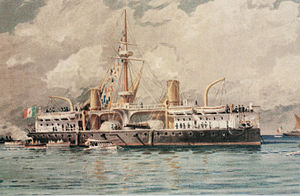
Duilio was the lead ship of the Duilio class of ironclad turret ships built for the Italian Regia Marina. Named for the Roman admiral Gaius Duilius, the ship was laid down in January 1873, was launched in May 1876, and was completed in January 1880. She was armed with a main battery of four 450 mm (17.7 in) guns, then the largest gun afloat, and she was capable of a top speed of around 15 knots.

Enrico Dandolo was the second of two Duilio-class ironclad turret ships built for the Italian Regia Marina in the 1870s. They were fitted with the largest guns available, 450 mm (18 in) rifled, muzzle-loading guns, and were the largest, fastest and most powerful ships of their day. Enrico Dandolo was built in La Spezia, with her keel laid in January 1873 and her hull launched in July 1878. Construction was finally completed in April 1882 when the ship, named for the 41st Doge of Venice, was commissioned into the Italian fleet.

Re Umberto was a Re Umberto-class ironclad battleship built for the Italian Regia Marina in the 1880s, the lead ship of her class. She was laid down in July 1884 and launched in October 1888; work proceeded so slowly that she was not finished until February 1893. She was armed with a main battery of four 343 mm (13.5 in) guns and had a top speed of 20.3 knots, though this high speed came at the cost of armor protection.

Sardegna was the third of three Re Umberto-class ironclad battleships built for the Italian Regia Marina. The ship, named for the island of Sardinia, was laid down in La Spezia in October 1885, launched in September 1890, and completed in February 1895. She was armed with a main battery of four 340 mm (13.5 in) guns and had a top speed of 20.3 knots —albeit at the cost of armor protection—and she was one of the first warships to be equipped with a wireless telegraph.

Italia was an Italian ironclad battleship built for the Italian Regia Marina, the lead ship of the Italia class. She and her single sister ship, Lepanto, had lengthy construction times. Italia was laid down in January 1876, launched in September 1880, and completed in October 1885. She was armed with a main battery of four 432 mm (17 in) guns mounted in a central barbette and was capable of a top speed of 17.8 knots. Unusually for ships of that era, Italia had an armored deck rather than the typical belt armor.

Lepanto was an Italian ironclad battleship built for the Italian Regia Marina, the second and last ship of the Italia class. Lepanto was laid down in November 1876, launched in March 1883, and completed in August 1887. She was armed with a main battery of four 432 mm (17 in) guns mounted in a central barbette and was capable of a top speed of 17.8 knots. Unlike other capital ships of the era, Lepanto had an armored deck rather than the more typical belt armor.

Francesco Morosini was an ironclad battleship built in the 1880s and 1890s for the Italian Regia Marina. The ship, named for Francesco Morosini, the 17th-century Doge of Venice, was the second of three ships in the Ruggiero di Lauria class, along with Ruggiero di Lauria and Andrea Doria. She was armed with a main battery of four 356 mm (14 in) guns, was protected with 451 mm (17.75 in) thick belt armor, and was capable of a top speed of 17 knots.

Andrea Doria was an ironclad battleship built for the Italian Regia Marina in the 1880s and 1890s. Named for the 16th-century Genoese admiral Andrea Doria, she was the third and final ship of the Ruggiero di Lauria class. The ship was armed with a main battery of four 432 mm (17 in) guns, was protected with 451 mm (17.75 in) thick belt armor, and was capable of a top speed of 17 knots.

Lombardia was a protected cruiser of the Italian Regia Marina built in the 1890s. The ship was the second of six vessels in its class, but was the first to enter service. Named for the region of Lombardy, she was laid down in November 1889, was launched in July 1890, and was completed in February 1893. The ship was equipped with a main armament of four 15 cm (5.9 in) and six 12 cm (4.7 in) guns, and she could steam at a speed of 18 knots.

Stromboli was a protected cruiser of the Italian Regia Marina built in the 1880s. She was the second member of the Etna class, which included three sister ships. She was named for the volcanic island of Stromboli, and was armed with a main battery of two 254 mm (10 in) and a secondary battery of six 152 mm (6 in) guns, and could steam at a speed of around 17 knots. Her career was relatively uneventful; the only significant action in which she took part was the campaign against the Boxer Uprising in China in 1900. She returned to Italy in 1901 and spent the rest of her career in reserve or as an ammunition ship, apart from a brief stint in active service in 1904. Stromboli was stricken from the naval register in 1907 and sold for scrapping in 1911.

Partenope was a torpedo cruiser built for the Italian Regia Marina in the 1880s, the lead ship of her class, which included seven other vessels. The ship was built by the Regio Cantiere di Castellammare di Stabia; she was laid down in June 1888, was launched in December 1889, and was completed in September 1890. Her main armament were her five torpedo tubes, which were supported by a battery of ten small-caliber guns.

Euridice was a torpedo cruiser of the Partenope class built for the Italian Regia Marina in the 1880s. She was built by the Regio Cantiere di Castellammare di Stabia shipyard, with her keel laying in February 1889, her launching in September 1890, and her commissioning in May 1891. Her main armament was her six torpedo tubes, which were supported by a battery of ten small-caliber guns. Euridice spent most of her career in the main Italian fleet, where she was primarily occupied with training exercises. She was withdrawn from service in 1907 and sold for scrapping.

Urania was a torpedo cruiser of the Partenope class built for the Italian Regia Marina in the 1880s. She was built by the Cantieri navali Odero shipyard; her keel was laid in February 1889, she was launched in June 1891, and was commissioned in July 1893. Her main armament were her six torpedo tubes, which were supported by a battery of ten small-caliber guns. Urania spent most of her career in the main Italian fleet, where she was primarily occupied with training exercises. She was still in service at the outbreak of the Italo-Turkish War in September 1911, but she did not take part in any operations. Instead, she remained in Italian waters and was broken up for scrap in January 1912.

Iride was a torpedo cruiser of the Partenope class built for the Italian Regia Marina in the 1880s. Laid down in February 1889 at the Regio Cantiere di Castellammare di Stabia shipyard, she was launched in July 1890 and was commissioned in November 1892. Her main armament were her six torpedo tubes, which were supported by a battery of ten small-caliber guns. Iride spent most of her career in the main Italian fleet, where she was primarily occupied with training exercises. During the Italo-Turkish War in September 1911, she remained in Italian waters until late in the conflict; she escorted a troop convoy to North Africa in April 1912 and bombarded Ottoman positions in June and July. Iride was eventually broken up for scrap in December 1920.

Calatafimi was a torpedo cruiser of the Partenope class built for the Italian Regia Marina in the 1880s. She was built by the Cantiere navale fratelli Orlando shipyard; her keel was laid in July 1891, she was launched in May 1894, and was commissioned in December 1895. Her main armament were her five torpedo tubes, which were supported by a battery of eleven small-caliber guns. Calatafimi spent most of her career in the main Italian fleet, where she was primarily occupied with training exercises. The ship was sold in March 1907 and broken up for scrap.

Saetta was a Folgore-class torpedo cruiser built for the Italian Regia Marina in the 1880s. Armed with three 14 in (356 mm) torpedo tubes and six light guns, she was capable of a top speed of 17 knots. She was built in the mid-1880s, was launched in May 1887, and was completed in February 1888. Saetta spent the first decade of her career serving in the main Italian fleet, where she conducted peacetime training exercises. In 1897, she was withdrawn from front-line service and employed as a gunnery training ship, a role she filled for another decade. The Regia Marina ultimately sold Saetta for scrap in May 1908.

Folgore was a torpedo cruiser built for the Italian Regia Marina, the lead ship of the Folgore class. Armed with three 14 in (356 mm) torpedo tubes and six light guns, she was capable of a top speed of 17 knots. She was built in the mid-1880s, was launched in September 1886, and was completed in February 1887. The ship spent her first two years in service either conducting training maneuvers with the main Italian fleet or in reserve status. She was badly damaged in a collision with the cruiser Giovanni Bausan in 1889, which reduced her effectiveness and cut her career short. Folgore spent the next eleven years primarily in the reserve, until she was sold for scrap in April 1901 and broken up.

Goito was a torpedo cruiser built for the Italian Regia Marina in the 1880s. She was the lead ship of the Goito class, which included three other vessels. Goito was built by the Regio Cantiere di Castellammare di Stabia shipyard between September 1885 and February 1888. She was armed with a variety of light guns and five 14-inch (356 mm) torpedo tubes, and was capable of a top speed of 18 knots. The ship served the duration of her career in the main Italian fleet. Her early service was primarily occupied with training exercises; front-line duties ended in 1897 when she was converted into a minelayer, though she continued to participate in fleet exercises. During World War I, Goito laid defensive minefields in the Adriatic Sea. She was eventually sold for scrap in 1920 and broken up.

Monzambano was a torpedo cruiser of the Goito class built for the Italian Regia Marina in the 1880s. The ship was built at the Arsenale di La Spezia, beginning with her keel laying in August 1885 and ending with her completion in August 1889. She was armed with a variety of light guns and five 14-inch (356 mm) torpedo tubes, and was capable of a top speed of 18 knots. The ship spent her career in the main Italian fleet conducting training exercises, and did not see action. She spent 1898 patrolling the eastern Mediterranean Sea with the Levant Squadron. Monzambano was withdrawn from service in 1901 and broken up for scrap that year.

Tripoli was the first modern torpedo cruiser built for the Italian Regia Marina. She was built by the Regio Cantiere di Castellammare di Stabia shipyard in 1885–86. The only vessel of her class, she provided the basis for the Goito and Partenope classes that followed. She was armed with five 14-inch (356 mm) torpedo tubes and a battery of light guns, and was capable of a top speed of 17.5 knots. Tripoli spent her career in the main Italian fleet, where she was occupied primarily with peacetime training exercises. She was modernized several times throughout her career, and in 1910, was converted into a minelayer, a role she served in for another thirteen years, including during World War I. She was the longest serving torpedo cruiser in the Italian fleet, with over 36 years in service by the time she was discarded in March 1923.





















